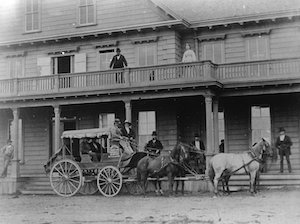by Wilma Tucker
Until the 1870s the Mendocino coast was isolated except for the schooners that sailed between San Francisco and Eureka. Travel inland was on foot or by horseback over narrow trails along the ridges.

The Coastline Mendocino to Cloverdale Stage, operated by Getz and Castro, in front of Carlson’s City Hotel on Main Street, c. 1880. (Kelley House Collection, Kelley House Photographs)
During the 1860s, roads were built between Mendocino and Cloverdale and between Mendocino and Ukiah, and stage lines came into being, carrying passengers, mail, supplies, gold for the payrolls, etc. By 1886, several stagecoaches arrived in Mendocino each day, and in 1888, two additional lines were in place.
Early editions of The Mendocino Beacon tell us that the stages were the large four-seated coaches drawn by either four- or six-horse teams. They seated 12 people, with two riding on top with the driver. In a later article, The Mendocino Beacon stated that “The Mendocino and Ukiah Stage Company commenced this week to run two-horse stages instead of four as heretofore, and as a consequence, stages arrived later.”
As for passenger comfort (or, rather, lack of it), besides closeness of the quarters, there was a ceaseless rocking of the coach. It rested on a suspension system of two long leather straps that were anchored to the coach at the front and rear axles and this created a ship-like motion as the stagecoach heaved and plunged along steep roads that had little grading.
Because the stages carried gold, there were many robberies in Mendocino County during these years. The last shooting holdup in the county was on the Ukiah Road about 26 miles east of Mendocino in March 1903.
How Mendocino Evolved by Chuck Bush – A Kelley House Museum publication covering the history of Mendocino and coastal growth during the logging years. $15.